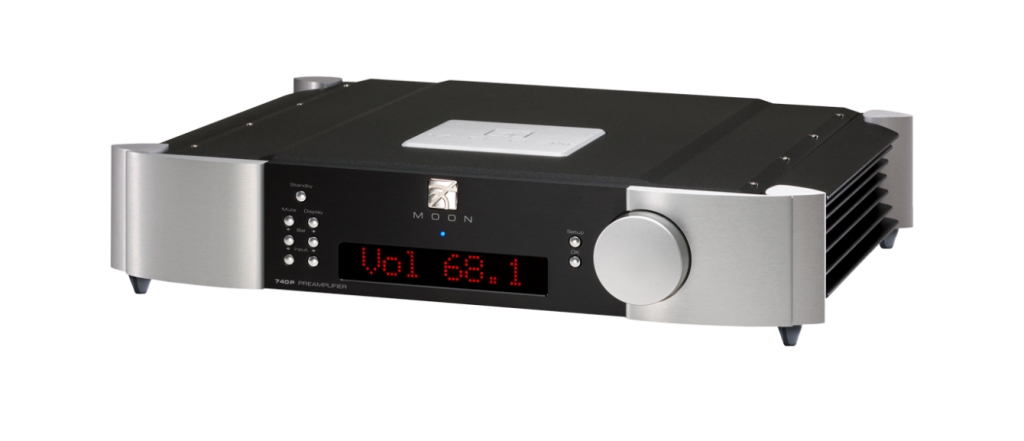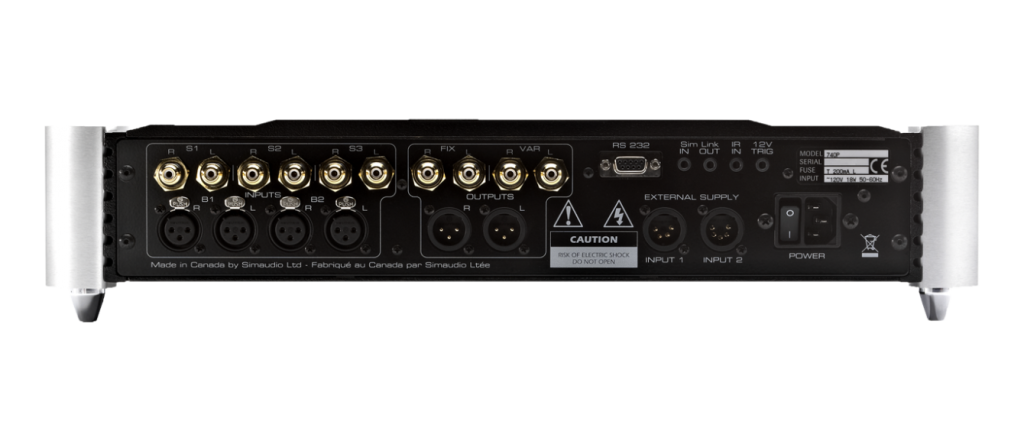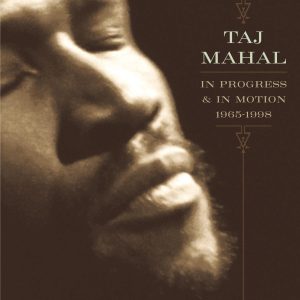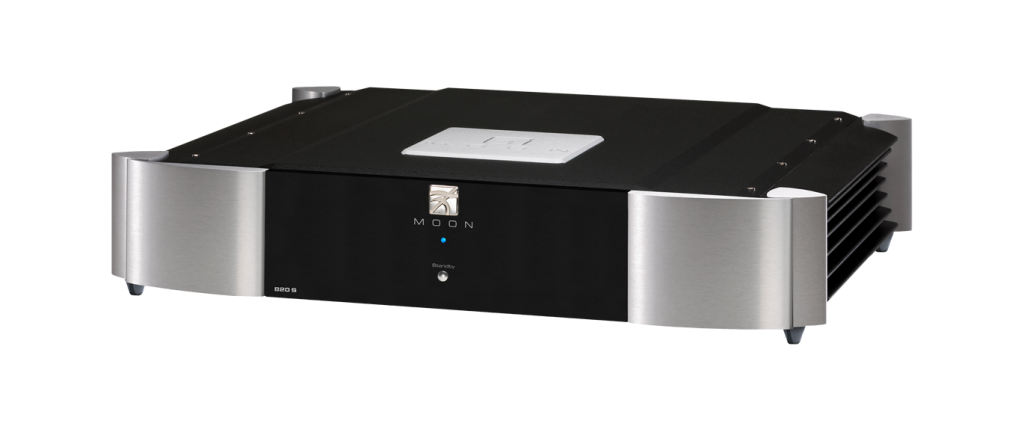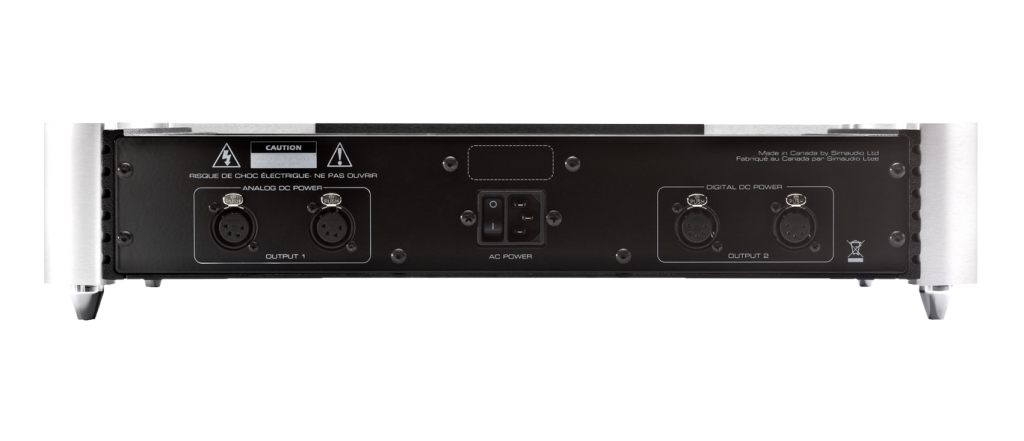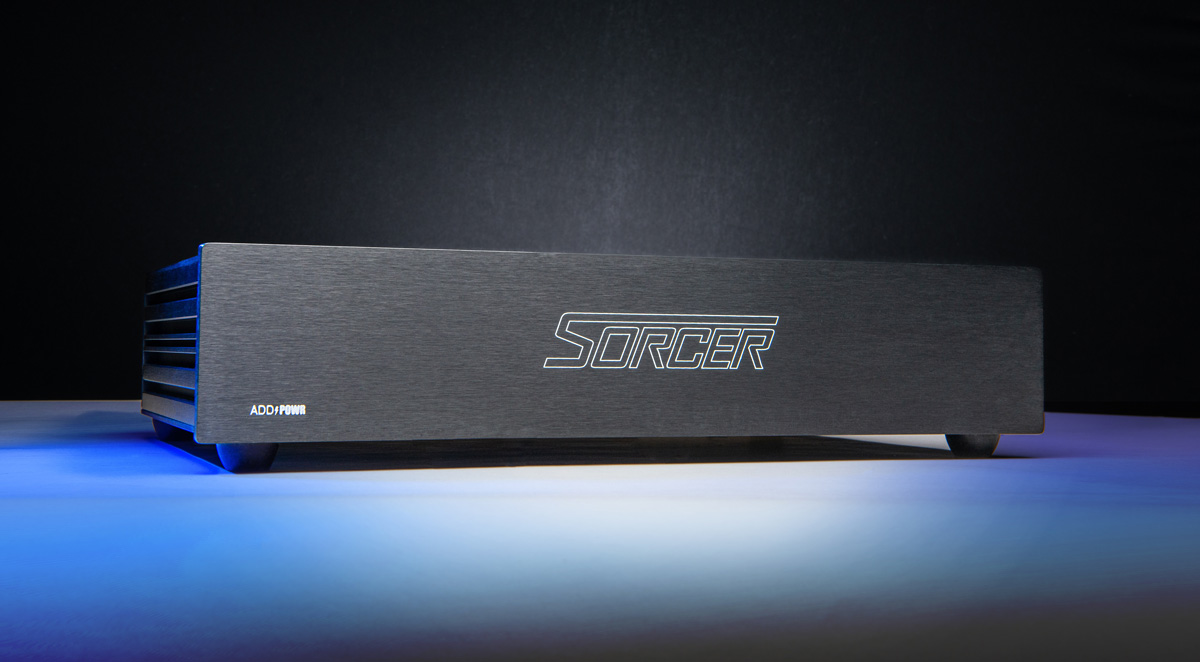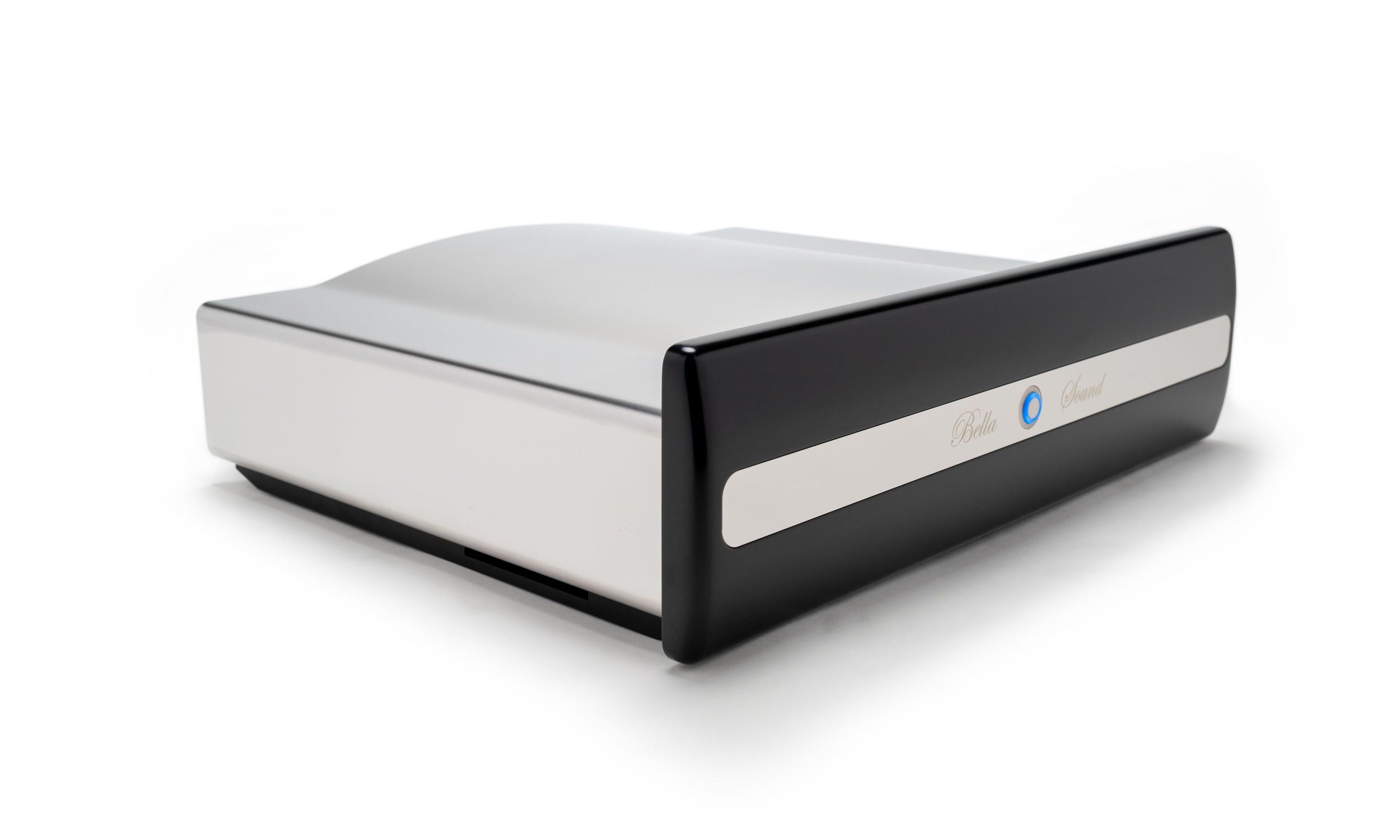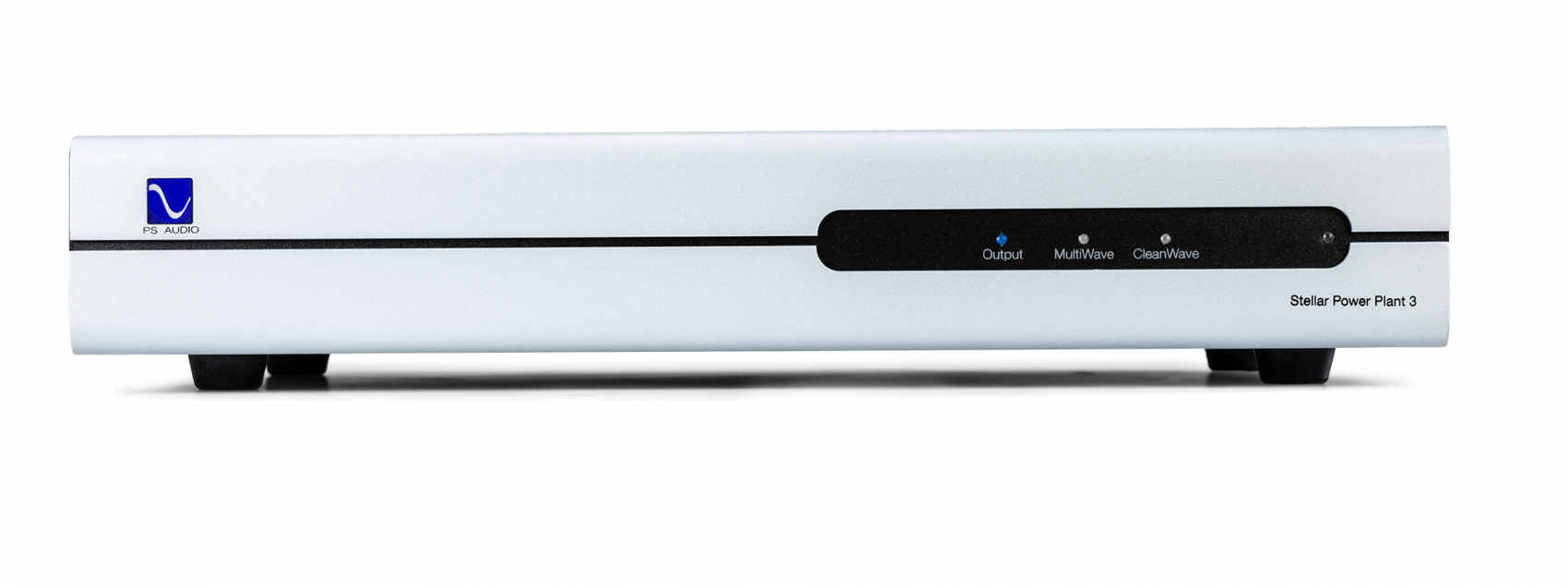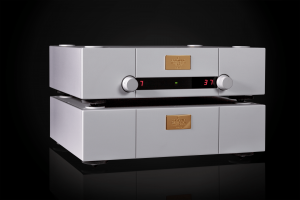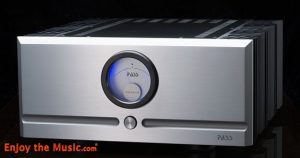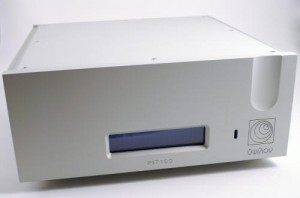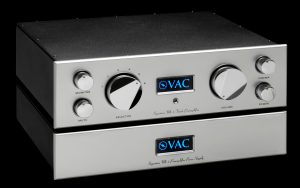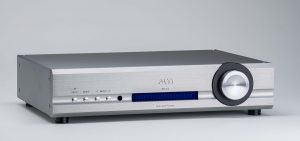The Simaudio Moon 740P preamplifier has been reviewed many times since its introduction circa 2012, most recently for Positive Feedback by Sam Rosen (HERE). I read many of these reviews, but not until after I had done my own evaluation. I am evaluating the 740P in conjunction with its companion piece the 820S External Power supply, but I'll start with of my impression of the 740P by itself.
Features
The 740P's dual mono design offers excellent channel separation, as evidenced by its crosstalk spec of 116dB @ 1kHz. With separate electronic crossovers and amplifiers for each channel, my system is as dual mono as I can manage. My own preamp is not dual mono, so I was interested to see if the switch to the 740P would audibly enhance channel separation.
The gain is a modest 9dB, but provides a good match when paired with Simaudio's own amps like the 860A v2 with its high-ish gain of 31dB. There are two pairs of balanced inputs and three pairs of single-ended inputs. This is an important consideration. Although this will suit many potential customers, I have more than two balanced sources, and so would have to consider an alternative. The 740P is heavily regulated with five stages of DC voltage regulation, and 24 stages of choke filtering resulting in a signal to noise ratio of 120dB @ full output. Of particular interest is the M-eVOL2 volume control circuit said to operate in a current steering R-2R configuration with 530 individual volume steps in .1dB and 1dB increments. In operation, this is one of the best volume controls I've used.
The left side of the front panel contains seven buttons Standby, Mute, Display, Balance up/down, and Input up/down. In the middle of the front panel under the Moon logo is a large display indicating volume level and briefly showing the input when selected. On the right of the 740P front panel are buttons labeled Setup and Ok next to a large rotary volume control. Setup allows for configuration of each input with labels, maximum volume level, offset volume, volume bypass when using the source components volume, 12-Volt trigger, Disable, and Reset. There is a full function remote control as well as the MiND app which allows control of Volume, Mute, Standby, etc. Simaudio's well written owner's manual covers all the various programming features and how to engage them. The review sample was in the popular two tone chassis also available in all black or all polished aluminum.
Setup
The manual suggests that the 740P will continue to improve for the first 400 hours of operation. That's a long break-in period. In order to hear it at its best I left it on and played an hour long break-in disc on repeat for days. Another way to help with break-in is to cycle power off for an hour or more, and once cooled off back on. This thermal shock will speed up break-in. It works well for amplifiers too. I did no serious listening until I was satisfied that I was close to optimum performance.
The 740P was situated on a Halcyonics Micro 40 active isolation platform atop a Lovan equipment stand where my own preamp usually sits. Cables were Soundstring Gen II and Mad Scientist Audio. Power was provided by a Jack Bybee/John Curl Signature power conditioner. I used both analog and digital sources in single ended and balanced configurations. Follow the link to my system description for more detail on this.
In my system the 740P was absolutely noise free. The 740P's gain was significantly lower than my own preamp and because of this it required running the volume control at the top of its range. I could adjust for this in my electronic crossovers, but found the available range adequate for the review period. Potential buyers should be mindful of the available gain and make sure that the 740P is paired with compatible amplifiers. It's always best to try it at home before you buy it. If you are dropping this much cash at a local audio emporium they should be able to make some arrangement. During the 740P's time here there were never any operational glitches or problems.
Programming shouldn't be too difficult. The user interface is straight forward, clear instructions are in the manual, and most features, once set, probably won't need to be accessed often. This is a beautiful and solidly built preamp weighing in at approximately 30 pounds. Dimensions are 18.75 x 4.0 x 16.5 inches. The feet are at the extreme corners, requiring a minimum shelf space of 19 x 17 inches. The 740P generated very little heat and I left it powered up all the time.
Listening
I started my listening with a 192kHz/24-bit download of The Ray Brown Trio's album Solar Energy. Ray Brown is my favorite bassist. With this release Ray coaxed pianist Gene Harris out of retirement and obscurity, kick-starting a second career for Harris. The Bop/Soul music on this disc exhibits lots of drive and energy, and remains a fan favorite after all these years. Double bass is always a good test, as is acoustic piano. The 740P has excellent articulation throughout its range, but bass articulation is particularly noteworthy. Bass was portrayed with exceptional grip and drive, handling the lowest notes with superb clarity. The resonant nature of the instrument was well controlled. Piano sound was clear, dynamic, and well extended. Instrument placement on the stage was unambiguous.
Next up was the 96kHz/24-bit cut "Tempted" by the group Squeeze from a multi-artist compilation. The only song with lead vocals by Paul Carrack from his only album with the band, this studio recording exhibits excellent imaging and instrument placement and space on the stage. The 740P reproduced all of this with a lively somewhat forward but very engaging sound. It portrayed all the imaging queues with a well-proportioned soundstage. Pace, rhythm, and timing were also well served.
I also sampled some live recordings, for example, Ben Sidran's On The Live Side featuring Steve Miller on guitar plus Phil Woods on alto sax, and ripped from CD. This album includes material from a studio album called On The Cool Side. The first half of the set is acoustic. The Moon 740P did a wonderful job with this material except for very low frequency ambiance and room acoustic cues, which were damped or non-existent. This is likely the side effect of all the power supply filtering and regulation. After all, ambiance is noise; it's just correlated to the room acoustic and the music. I've heard this same effect in the Moon 390 Network player, even via the headphone output, and in the 680D DAC, both of which I reviewed last year, so it isn't an anomaly it's more of a house sound. It is likely that, unless you have a very robust low end, this ambiance info could fall outside your speaker's range. In other words, you wouldn't miss it.
A three CD set of Taj Mahal called In Progress & In Motion 1965 – 1998 did time in my playlist. Spanning three decades it gives a good overview of his career up to that point. I was particularly interested in how the 740P would handle the National steel guitar that Mahal plays on "Stagger Lee." This song dates back to 1897, and there are several variations and iterations including whole verses that aren't in the Taj Mahal version. None the less, it is well told here. The 740P captured the micro and macro dynamics of the instrument quite well. Taj's voice was warm, detailed, and inviting. The Moon 740P was so engaging that, if not careful, one could forget about reviewing and fall into the music.
Conclusion
The Simaudio Moon 740P preamp is beautifully constructed inside and out, well designed, and excellent sounding with a versatile feature set. It exhibits clarity, dynamics, soundstaging, and articulation that are all first rate. It is no wonder that the 740P has remained unchanged all this time. Why mess with a good thing?
Simaudio Moon 820S external power supply
The 820s is designed to upgrade the performance of up to two of the following Moon Series products: (740P, 650D, 750D, 680D, 780D, 610LP, or 810LP.) If you already have two of these products it's an obvious upgrade path and, given its price, more cost effective than buying it just for one product. A list of its features includes custom proprietary toroidal transformers, special pi-type filters, and four stages of voltage regulation. The specifications list total capacitance at 80,000 microfarads, and total inductance at 80mH.
The chassis of the 820S is much the same as that of the 740P except for the front and rear panels. Several of the Moon Series components share this chassis, as well as shipping containers and packing. A set of four unique triangular extension legs called "Bridges" will allow two Moon Series components to be securely stacked. Check the website.
The rear panel is where all the action is. There are two sets of outputs labeled Analog and two sets labeled Digital. Outputs are on XLR like barrel connectors, the Analog connections having four pins and the Digital connections having five. There is no way to plug them in wrong. Output voltages are listed as +/- 20 V for Analog and +14 V for Digital. Two full sets of connecting cables come with the unit. They are long enough to allow placement flexibility. There is a centrally located IEC power inlet and On/Off switch. The 820S weighs in at about 35 pounds.
I placed the 820S in one of my Lovan equipment racks below the 740P preamp, disconnected the power cord from the 740P, and attached the connecting cables from the 820S. The 820S was powered straight from an Audience Hidden Treasure wall outlet on a dedicated circuit with a Soundstring Gen II power cord. I let everything warm up for a couple of days before I did any serious listening. There was no mention of break-in time for the 820S in the owner's manual.
Listening
The sonic effects of the 820S external supply were immediately obvious. This was full spectrum take no prisoners sound. Everything had more muscle and more authority. Bass was still articulate, but now it was downright adamant. Harmonic saturation and detail retrieval were significantly boosted. Presumably, the 820S completely bypasses the internal supplies of the attached devices. Technically speaking, this means the 740P is no longer dual mono when connected to the 820S since one supply powers both channels but I don't think anyone will complain. I heard no reduction in channel separation or signal to noise ratio. What I did hear was a delightfully rich palette of sound.
The 820S took every characteristic of the 740P and dialed it up a significant notch. I also tried the 680D DAC in the system connected to the 820S with similar results. In terms of muscle it was like going from Ryan Reynolds to Arnold Schwarzenegger without losing any musical agility. Musical images had more flesh and substance, rendering the performers more vividly on the soundstage. When everything in the music was going full tilt and the stage was cluttered the 820S helped keep everything well sorted.
Final Conclusion
The Moon 740P preamp is an accomplished piece of kit at this price point, and adding the 820S creates a formidable combination. I was impressed by the effect the Simaudio Moon 820S external power supply had on associated equipment. It exceeded my expectations. Removing the Simaudio equipment and going back to my own preamp also left an impression. Frequently, it is easier to hear the contrast between two pieces of gear after you've acclimated yourself to the new gear and then switch back and that was the case here. All the 820S's drive and power were missing and the music seemed a bit mild.
Anyone who already owns compatible Simaudio equipment or is considering a purchase should definitely audition the 820S supply. I very much enjoyed my time with all the Simaudio gear I've had the privilege of auditioning. Thanks, Simaudio, for the opportunity to hear your creations.
740P Preamplifier
Retail: $9500
820S External Power Supply
Retail: $8500
Simaudio




